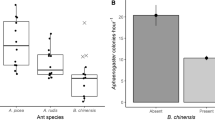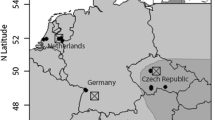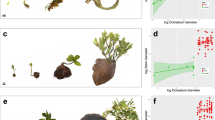Abstract
Climate change prompts warm-tolerant species upward and poleward to either displace or replace cold-tolerant species. Warm-tolerant species may replace cold-tolerant individuals with upward migration, or cold-tolerant genes if the species hybridize. We examined genetic and morphological differences between low elevation, warm-tolerant (Aphaenogaster rudis) and high elevation cold-tolerant (A. picea) ant species that form an upward-shifting ecotone in the southern Appalachian Mountains (USA). The A. picea/A. rudis ecotone shifted upward ca. 200 m between the decades 1970 and 2010, and characteristic morphological traits appeared muddled where the species met, suggesting hybridization. However, we found no evidence of genetic hybridization, and the trait most associated with species identity, pigmentation, remained so across the environmental gradients. Conversely, femur length did not differentiate well between species identities, and it shifted across the environmental gradients. These results suggest that the cold tolerant A. picea, associated with high-elevation and high-latitude, was replaced by the warm-tolerant, low elevation A. rudis species. As such, these results suggest that less competitive cold-tolerant species may be replaced by more competitive cold-intolerant species with climate warming.




Similar content being viewed by others
References
Brady SG, Schultz TR, Fisher BL, Ward PS (2006) Evaluating alternative hypotheses for the early evolution and diversification of ants. Proc Natl Acad Sci USA 273:1643–1649
Brommer JE (2004) The range margins of northern birds shifts polewards. Ann Zool 41:391–397
Bruce RC (2007) Out of the frying pan into the fire: an ecological perspective on evolutionary reversal in life history in plethodontid salamanders (Amphibia: Plethodontidae). Evol Ecol 21:703–726
Buggs RJA (2007) Empirical study of hybrid zone movement. Heredity 99:301–312
Cahan SH, Keller L (2003) Complex hybrid origin of genetic caste determination in harvester ants. Nature 424:306–309
Castoe TA, Doan TM, Parkinson CL (2004) Data partitions and complex models in Bayesian analysis: the phylogeny of gymnophthalmid lizards. Syst Biol 53:448–469
Chase JM, Leibold MA (2003) Ecological niches: linking classical and contemporary approaches. University of Chicago, Chicago
Connell JH (1975) Some mechanisms producing structure in natural communities: a model and evidence from field experiments. In: Cody ML, Diamond JM (eds) Ecology and evolution of communities. Harvard University Press, Cambridge, pp 460–490
Creighton WS (1950) The ants of North America, vol 104. Bull Mus Comp Zool. The Cosmos Press, Inc., Cambridge
Crozier RH (1977) Genetic differentiation between populations of the ant Aphaenogaster ‘rudis’ in the southeastern United States. Genetica 47:17–36
De Marco B, Cognato AI (2016) A multiple gene phylogeny reveals polyphyly among eastern North American Aphaenogaster species (Hymenoptera: Formicidae). Zool Scrip. doi:10.1111/zsc.12168
Delcourt HR, Delcourt PA (1987) Long-term forest dynamics of the temperate zone. Springer, New York
Delcourt HR, Delcourt PA (2000) Eastern deciduous forests. In: Barbour MG, Billings WD (eds) North American terrestrial vegetation. Cambridge University Press, Cambridge
Dunn RR, Parker CR, Sanders NJ (2007) Temporal patterns of diversity: assessing the biotic and abiotic controls on ant assemblages. Biol J Linn Soc 91:191–201
Ellers J, Boggs CL (2004) Functional ecological implications of intraspecific differences in wing melanization in Colias butterflies. Biol J Linn Soc 82:79–87
Ellison AM, Gotelli NJ, Farnsworth EJ, Alpert GD (2012) A field guide to the ants of New England. Yale University Press, New Haven
Greiner B, Narendra A, Reid SF, Dacke M, Ribi WA, Zeil J (2007) Eye structure correlates with distinct foraging-bout timing in primitive ants. Curr Biol 17:R879–R880
Hairston NG (1949) The local distribution and ecology of the Plethodontid salamanders of the Southern Appalachians. Ecol Monogr 19:49–73
Hairston NG (1951) Interspecies competition and its probable influence upon the vertical distribution of Appalachian salamanders of the genus Plethodon. Ecology 32:266–274
Hairston NG, Wiley RH, Smith CK, Kneidel KA (1992) The dynamics of two hybrid zones in Appalachian salamanders of the genus Plethodon. Evolution 46:930–938
Harr B, Price T (2014) Climate change: a hybrid zone moves north. Curr Biol 24:230–232
Highton R, Peabody RB (2000) Geographic protein variation and speciation in salamanders of the Plethodon jordani and Plethodon glutinosus complexes in the southern Appalachian mountains with the description of four new species. In: Bruce RC, Jaeger RG, Houck LD (eds) The biology of Plethodontid Salamanders. Kluwer Academic/Plenum, New York
Huelsenbeck JP, Ronquist F (2001) MRBAYES: Bayesian inference of phylogenetic trees. Bioinformatics 17:754–755
Hurlbert SH, Lombardi CM (2009) Final collapse of the Newman-Pearson decision theoretic framework and the rise of the neoFisherian. Ann Zool 46:311–349
Ibanez I, Clark JS, Dietze MC (2008) Evaluating the sources of potential migrant species: implications under climate change. Ecol Appl 18:1664–1678
Julian GE, Fewell JH, Gadau J, Johnson RA, Larrabee D (2002) Genetic determination of the queen caste in an ant hybrid zone. Proc Natl Acad Sci USA 99:8157–8160
Kaspari M, Clay NA, Lucas J, Yanoviak SP, Kay A (2015) Thermal adaptation generates a diversity of thermal limits in a rainforest ant community. Glob Change Biol 21:1092–1102
Kelly AE, Goulden ML (2008) Rapid shifts in plant distribution with recent climate change. Proc Natl Acad Sci USA 105:11823–11826
King JR, Warren RJ II, Bradford MA (2013) Social insects dominate eastern US temperate hardwood forest macroinvertebrate communities in warmer regions. PLoS One 8:e75843
Lubertazzi D (2012) The biology and natural history of Aphaenogaster rudis. Psyche 2012:752815
Menge BA, Sutherland JP (1987) Community regulation—variation in disturbance, competition, and predation in relation to environmental-stress and recruitment. Am Nat 130:730–757
Miller MA, Pfeiffer W, Schwartz T (2010) Creating the CIPRES science gateway for inference of large phylogetic trees. In: Proceedings of the gateway computing environment workshop (GCE), New Orleans, LA, USA
Miller-Rushing AJ, Lloyd-Evans TL, Primack RB, Satzinger P (2008) Bird migration times, climate change, and changing population sizes. Glob Change Biol 14:1959–1972
MontBlanc EM, Chambers JC, Brussard PF (2007) Variation in ant populations with elevation, tree cover, and fire in a pinyon-juniper-dominated watershed. West N Am Nat 67:469–491
Ness JH, Morin DF, Giladi I (2009) Uncommon specialization in a mutualism between a temperate herbaceous plant guild and an ant: are Aphaenogaster ants keystone mutualists? Oikos 12:1793–1804
Nylander JAA, Ronquist F, Huelsenbeck JP, Nieves-Aldrey J (2004) Bayesian phylogenetic analysis of combined data. Syst Biol 53:47–67
Parkash R, Munjal AK (1999) Phenotypic variability of thoracic pigmentation in Indian populations of Drosophila melanogaster. J Zool Syst Evol Res 37:133–140
Parmesan C et al (1999) Poleward shifts in geographical ranges of butterfly species associated with regional warming. Nature 399:579–583
Parr CL, Gibb H (2009) Competition and the role of dominant ants. In: Lach L, Parr CL, Abbott KL (eds) Ant ecology. Oxford University Press, Oxford, pp 77–96
Pearce-Duvet JMC, Elemans CPH, Feener DH Jr (2011) Walking the line: search behavior and foraging success. Behav Ecol 22:501–509
Pelini SL, Dzurisin JDK, Prior KM, Williams CM, Marsico TD, Sinclair BJ, Hellmann JJ (2009) Translocation experiments with butterflies reveal limits to enhancement of poleward populations under climate change. Proc Natl Acad Sci USA 106:11160–11165
Perry AL, Low PJ, Ellis JR, Reynolds JD (2005) Climate change and distributional shifts in marine fishes. Science 308:1912–1915
R Development Core Team (2016) R: a language and environment for statistical computing. R Foundation for Statistical Computing, Vienna
Robinson CH (2001) Cold adaptation in Arctic and Antarctic fungi. New Phytol 151:341–353
Sanders NJ, Lessard JP, Fitzpatrick MC, Dunn RR (2007) Temperature, but not productivity or geometry, predicts elevational diversity gradients in ants across spatial grains. Glob Ecol Biogeogr 16:640–649
Schweiger O, Settele J, Kudrna O, Klotz S, Kuhn I (2008) Climate change can cause spatial mismatch of trophically interacting species. Ecology 89:3472–3479
Seifert B (2009) Cryptic species in ants (Hymentoptera: Formicidae) revisited: we need a change in the alpha-taxonomic approach. Myrmecol News 12:149–166
Shoemaker DD, Ross KG, Arnold ML (1996) Genetic structure and evolution of a fire ant hybrid zone. Evolution 50:1958–1976
Tilman D, Pascala S (1993) The maintenance of species richness in plant communities. In: Ricklefs RE, Schluter R (eds) Species diversity in ecological communities. University of Chicago Press, Chicago
Umphrey GJ (1996) Morphometric discrimination among sibling species in the fulva-rudis-texana complex of the ant genus Aphaenogaster (Hymenoptera: Formicidae). Can J Zool 74:528–559
Urban MC, Tewksbury JJ, Sheldon KS (2012) On a collision course: competition and dispersal differences create no-analogue communities and cause extinctions during climate change. Proc R Soc B Biol Sci 279:2072–2080
Ward PS, Brady SG, Fisher BL, Schultz TR (2010) Phylogeny and biogeography of dolichoderine ants: effects of data partitioning and relict taxa on historical inference. Syst Biol 59:342–362
Warren RJ II, Bradford MA (2013) Mutualism fails when climate response differs between interacting species. Glob Change Biol 20:466–474
Warren RJ II, Chick L (2013) Upward ant distribution shift corresponds with minimum, not maximum, temperature tolerance. Glob Change Biol 19:2082–2088
Warren RJ II, Bahn V, Bradford MA (2011a) Temperature cues phenological synchrony in ant-mediated seed dispersal. Glob Change Biol 17:2444–2454
Warren RJ II, McAfee P, Bahn V (2011b) Ecological differentiation among key plant mutualists from a cryptic ant guild. Insect Soc 58:505–512
Wolf DE, Takebayashi N, Rieseberg LH (2001) Predicting the risk of extinction through hybridization. Conserv Biol 15:1039–1053
Zhu K, Woodall CW, Ghosh S, Gelfand AE, Clark JS (2013) Dual impacts of climate change: forest migration and turnover through life history. Glob Change Biol 20:251–264
Zuckerberg B, Woods AM, Porter W (2009) Poleward shifts in breeding bird distributions in New York State. Glob Change Biol 15:1866–1883
Acknowledgments
Partial support for this research was provided by the SUNY Buffalo State Office of Undergraduate Research. Additional funding was provided to LDC through National Science Foundation Grant 1136703—Dimensions in Biodiversity: Collaborative Research: The climate cascade: functional and evolutionary consequences of climatic change on species, trait, and genetic diversity in a temperate ant community to PIs: Nate Sanders, Aaron Ellison, Nick Gotelli, Sara Helms Cahan, Bryan Ballif, and Rob Dunn. We also thank Highlands Biological Stations Director Jim Costa and staff for support; Victor Agraz, Deborah Jackson, Mary Schultz, Chris Broecker, Havish Deepnarain, Nicole Dexter, Jesse Helton, Jing Niu, Vidhyaben Patel, Zeph Pendleton, Rachel Power, Paula Reith, Morgan Spinelli for field help. We thank the Georgia Department of Natural Resources Nongame Conservation Section and the US Forest Service Chattahoochee-Oconee National Forest for permission to collect ants. We also thank Georgia Museum of Natural History Curator and Collections Manager Richard Hoebeke for loaning us Aphaenogaster specimens from R. H. Crozier’s collections.
Author information
Authors and Affiliations
Corresponding author
Electronic supplementary material
Below is the link to the electronic supplementary material.
Rights and permissions
About this article
Cite this article
Warren, R.J., Chick, L.D., DeMarco, B. et al. Climate-driven range shift prompts species replacement. Insect. Soc. 63, 593–601 (2016). https://doi.org/10.1007/s00040-016-0504-0
Received:
Revised:
Accepted:
Published:
Issue Date:
DOI: https://doi.org/10.1007/s00040-016-0504-0




